The standard battery bank on the Airstream consists of two 12-volt group 24 batteries connected in parallel stored just in front of the trailer and behind the propane tanks. Group 24 batteries are designed to hold around 75 amp hours of power each. At a full charge, they store just enough juice for you to run all the lights in the Airstream for about 2 seconds. OK, maybe that is a slight exaggeration, but the power-hungry halogen bulbs Jackson Center, Ohio installed into our 25 foot International are not really designed with boondockers in mind. Bright and warm as they might be, they are very inefficient. Many people have swapped them out for expensive LED versions of these lights bought from Internet sources. The problem with this ‘upgrade’ is that in return of them running forever, you have to deal with these dim little blue lights that makes you feel like you are living in the International Space Station.
Solar panels and generators are great for creating portable power but you need more batteries to hold all those amps generated for when they are not pumping the voltage into our beloved puck lights. That’s especially true for solar panels since they obviously only work when there is day light. Our 25 ft Airstream International FB (Front Bedroom) model gives us the aftermarket option to store some additional batteries in the storage space under the bed. To store deep cycle batteries inside the living space of the trailer means they have to be maintenance-free, sealed versions of these batteries that can sometimes cost twice as much.
As we get closer and closer to hitting the road full time, we are trying to be very careful with budgeting our traveling funds. That means we have to make use with what we already have versus buying more gear unless its absolutely necessary. In my old days as a sailboat owner, I gathered a lot of sailboat cruising related gear. After selling the boat to make room for the Airstream, I kept a couple of lightly-used deep cycle batteries thinking that they might come in handy one day. Unfortunately they were not the sealed versions so they will not be going inside and under the bed.
After some measuring and scrounging in the garage, I came up with an old Igloo cooler that fits these 2 batteries perfectly. With a few holes drilled for ventilation, the batteries dropped in and were wired up in parallel with some 10-gauge wires.
The weight of the batteries make the cooler a chore to carry but the handles on the side work well to bear the load with 2 people. A 7-amp solar charge controller connected to the system allows me to maintain these batteries with a small solar cell to keep them topped off in between trips.
A little terminal block with dual bus plates is used to connect everything to a heavy duty marine battery switch by Perko. The 4-position switch gives me the option to use 1, 2, both or none of the batteries as needed.
You might be wondering now how this homemade contraption allows me to run any of the electrical systems in the Airstream. If you own a travel trailer with a 7-pin hitch connector, you know that the car sends a 12-volt charge to the trailer’s batteries through one of the pins in the connector. The diagram below shows you what each one of those 7 pins do.
By connecting the 12-volt pin and the ground pin to the matching position in a female plug purchased from a trailer store, I mounted them on the outside of the cooler. By simply plugging the trailer into the box, I am now able use the electricity stored in this magical Igloo cooler. What’s even cooler is that it will even charge these batteries the same way when I have a 30-amp power hookup or by running our new-to-us Honda EU2000i generator. In one of the little holes I drilled out in the front of the cooler, I placed a cigarette lighter adaptor that will also allow me to use the power output for things like a 12-volt air compressor while airing up the tires or running a laptop through a small inverter while sitting at the picnic table.
We have yet to try this setup with the Airstream but it should come in handy at a dry campground to help run that power hungry furnace fan at night when we are not allowed to run the generator. If you decide to build one of these for yourself, be sure to get the heaviest gauge wires you can get your hands on and be very careful not to draw too much load through the trailer harness. Refer to other electrical experts other than just what you see here. You wouldn’t want an electrical fire on your hands. I would keep the extinguisher near just in case.
over and out,
dan
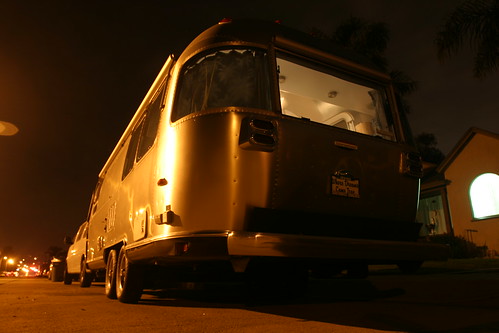
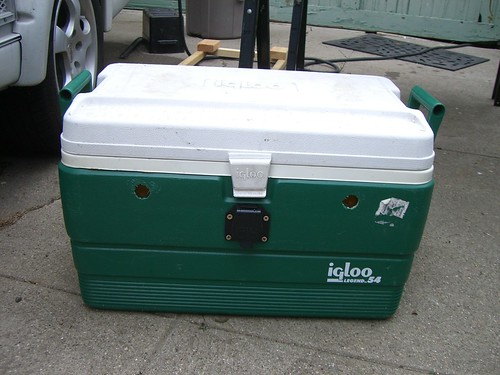
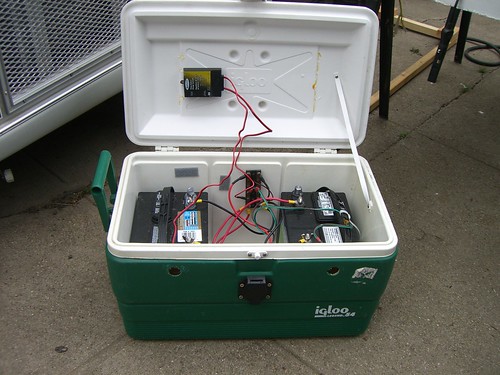
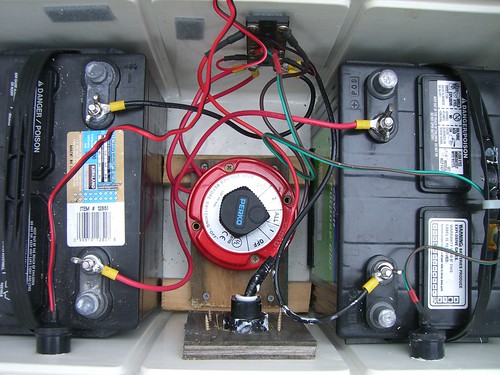


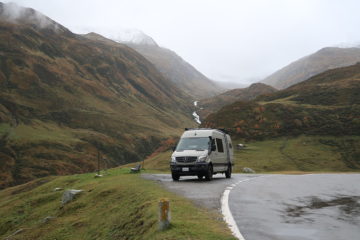


7 Comments
Tim · February 12, 2009 at 12:22 pm
Great post, and great idea
Rich Luhr · February 13, 2009 at 7:51 am
Very clever, Dan! I always advise people to install extra battery power before they go with solar, or buy a generator. It’s the best bang for the buck overall. The only issue is weight, and where to put the batteries. Looks like you’ve solved those problems by making the batteries portable.
Roger · February 24, 2009 at 3:13 pm
I really like this idea and I have a place to store it on trips (the bed of the truck). Another thing that is fun to have is a switch for your running lights. I have a female connector that loops two wires with a fuse. I believe it is the brown and black. That way I can have my running lights on for some ambiance when we are parked. It helps the drain if you have all LED’s in the lights.
Mark · June 13, 2010 at 6:03 pm
I also find that my Airstream ’06 Safari SE 28ft rear bed, which is also equipped from factory with 2 group 24 Batteries is well under powered for the amount of electrical equipment onboard, especially if boondocking, even overnight. When we purchased the trailer we bought a 3500i Generator, but to charge the 2 batteries off the convertor takes all day, so one must use a rapid battery charger, and that still is hours of generator noise not to mention you still don’t have enough juice to do much after dark. We try to avoid boondocking because we don’t want to disturb the quietness of the surroundings with the noise of a 65db generator. My current plan now that I am a little more mobile (another story) is to set up a 3 bank battery system, 4 if you include the tow vehicle battery. I will replace the group 24 12volts with a pair of 6volt batteries in series for 12volt total. The existing battery box is just big enough for that, next I will add a high output alternator to my Dodge truck, I can get a good quality 225volt highout put with proper voltage regulation for the truck systems and marine style switching for the 2 battery battery banks I will set up in the bed of the truck, along the sides of the bed slide tray that is installed to load and unload gear. My plan is to install 1or 2 size 8D industrial 12volt baterries on either side of the bed slide. From my measurments I have enough room. I also have heavy duty wiring form the engine compartment to the inside of the canopy from a prior camper 7 way plug that had been installed which I thing can be reused to route the wiring. this should give me close between 800 and 900amp/hrs of stored power between the 2 banks which I will connect to the trailer with a 12 volt quick connect to the existing original battery bank. I have not run this by my trailer mechanic but I think it will work, and we will back it up with both a solar power bank and the generator when and if needed. Which should give us more then adequate boondocking ability for camping off grid and away from the crowds. Any comments or suggestions would be appreciated.
Am I overshooting the mark. BTW my dodge has plenty of load capacity for the batteries so weight is not an issue in the truck. and the canopy has a full 12 foot expanded steel mesh covered ladder rack that solar panels can be attached to.
Staziak · June 27, 2019 at 8:31 am
Clever…but cooler will not hold up. It will not support the weight of two batteries.
Mali Mish - Let Go. » Blog Archive » The Never Ending Debate: Generator vs. Solar Panels. · February 19, 2009 at 12:07 am
[…] « Our Portable Battery Bank. […]
Good news, bad news | Nuestra casa rodante - Our Airstream, travels and such... · October 5, 2009 at 8:34 pm
[…] has done a great job in conserving. As far as power, I created my extra battery box similar to this one so we have had 4 batteries for the duration. However we have been running the generator regularly […]